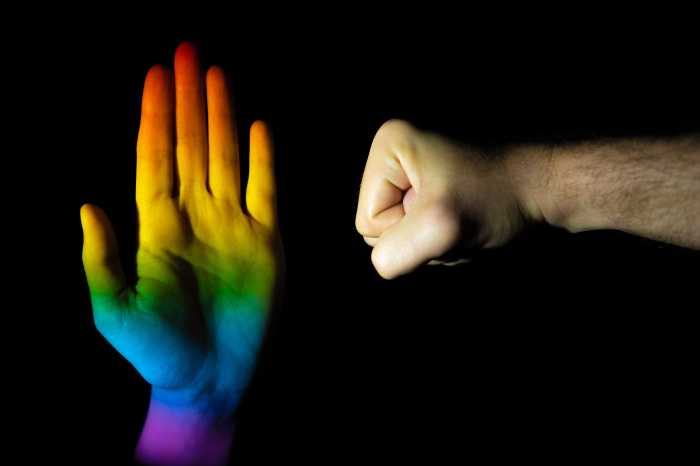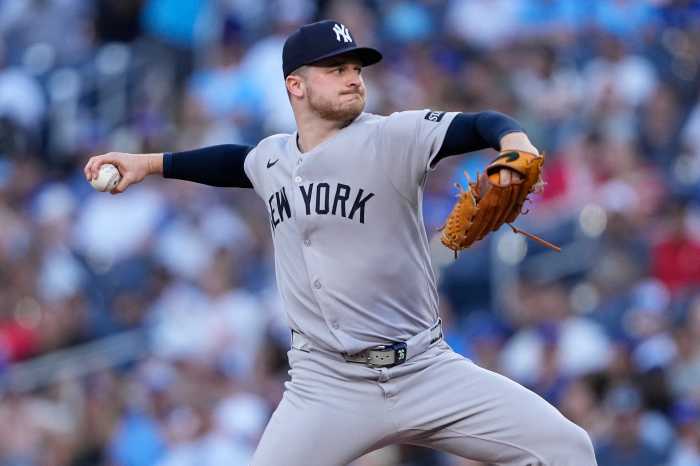The months-long protests over police brutality and systemic racism has mobilized hundreds of thousands of New Yorkers — and one of the main calls coming from community members and elected officials is to “defund the police.” But what does that mean?
Although it might be a confusing statement at first, advocates say the calls to defund the police translate to directly investing in communities and prioritizing social services over a criminal justice system that perpetuates the disproportionate abuse of Black, Brown, immigrant and minority communities.
The goal is to provide people with the basic resources they need to live better lives, such as inclusive education, affordable housing and accessible health care — services many say are desperately needed now more than ever due to COVID-19’s impact.
“We need to direct cost-savings towards the Department of Youth and Community Development, education and adult literacy, housing, housing the homeless, and social services that keep our communities safe and healthy,” Make the Road NY wrote in their call to defund the police and have police free schools.
Some may argue those social services already exist and are adequate, but if that were the case — why are schools overcrowded? Why is there a housing crisis while there are more than 90,000 New Yorkers who are homeless? Why was the health and hospital system overburdened once COVID-19 hit, leaving low-income and minority neighborhoods to suffer the worst of it?
When it comes down to city and state budget negotiations, oftentimes it’s social services working to address those issues that either don’t get a budget increase or are among the first to get cut.
In the time of the pandemic, which Mayor Bill de Blasio said has left the city with a $9 billion deficit, there have already been cuts to programs that have a positive impact on the city’s youth — namely, the suspension of the Summer Youth Employment Program.
The program was one of the first to go due to COVID-19 fears and the budget crisis, but community members and City Council members believe it was a mistake.
Councilman Donovan Richards, who’s the chair of the Council’s Committee on Public Safety, addressed the issue during a rally for the repeal of 50-A on June 4.
“The mayor has the gall to want to cut the Department of Youth and Community Development’s budget by 48 percent, the mayor proposed to cut the Summer Youth Employment program,“ Richards said. “If you’re a mayor who’s standing for justice and inequality … you would only cut one percent of the NYPD’s budget. Yet, the mayor proposed to graduate a new police class at the cost of $25 million.”
According to Schools Chancellor Richard Carranza, the DOE’s budget was also facing hundreds of millions in budget cuts. The DOE planned to cut the “Single Shepherd” program, which placed 130 counselors and social workers in historically underserved neighborhoods in the Bronx and Brooklyn, according to the New York Daily News.
During a Tuesday, June 30, press briefing, de Blasio said the 2021 budget will restore the DOE’s budget and fund the “Single Shepherd” program.
Activists and elected officials are calling for priorities to shift moving forward.
NYPD among top three city agencies with largest budget
Expenses for the NYPD will total almost $11 billion in 2020, comprised of the NYPD’s nearly $6 billion operating budget and $5.3 billion of costs “centrally allocated” of city funds, including $2.3 billion for fringe benefits, $2.8 billion for pensions, and $215 million for debt service, according to the Citizens Budget Commission. The NYPD’s centrally allocated costs are significantly high since uniformed health insurance and pension benefits are “more generous than for other city employees,” according to the CBC.
The NYPD is among the top three city agencies with the largest operating budgets, after the Departments of Education (DOE) and Social Services (DSS). The NYPD’s budget, including the centrally allocated expenses, accounts for 11 percent of the city’s current $98 billion budget.
In April, while the mayor’s executive budget for 2021 showed significant cuts to other sectors, the NYPD’s budget was “mostly left intact,” according to Public Advocate Jumaane Williams.
The City Comptroller’s office recommended the city cut $1 billion over four years, with $265 million in cuts annually by reducing uniformed headcount through attrition, scaling back overtime and trimming Other Than Personnel Services.
“Breaking down structural racism in New York City will require long-term, lasting change — and that must include reducing the NYPD’s budget,” Comptroller Scott Stringer said. “If our budget is a reflection of our values, it is unconscionable that services for Black and Brown New Yorkers are on the chopping block while the NYPD’s budget remains almost entirely untouched.”
First steps to change policing
The City Council committed to cutting $1 billion from the NYPD’s 2020-21 budget as a response to the marches and demonstrations across New York City, which were sparked by the police killing of Minneapolis’ George Floyd, Louisville’s Breonna Taylor and countless other Black people in the United States.
As a result of the Black Lives Matter demonstrations — some of which have been met with police violence and a questionable curfew instated by the city earlier in the month — the city banned the use of chokeholds and Gov. Andrew Cuomo signed into law a repeal of 50-A to grant more transparency of the NYPD.
But these are just some steps that are part of a bigger movement to fundamentally change the way policing works, not only in the city but the whole nation.
“It’s not just about police reform; it’s about educational reform, mental health reform, social service reform. It’s about health care reform and environmental justice reform,” said Jamaell Henderson, a professor at City University and from the CUNY Rising Alliance, at a press briefing on the steps of Tweed Courthouse on Sunday, June 28.
Some ideas to immediately address those reforms include having professionals trained in mental health, substance and/or domestic abuse deal with people who need intervention rather than police — as people with untreated mental illness are 16 times more likely to be killed during a police encounter, according to the Treatment Advocacy Center. Advocated have also called for investment in drug rehabilitation rather than punishment as another way to address those underlying needs.
The months-long demonstrations have culminated with a sit-in at City Hall, or Occupy City Hall, spearheaded by VOCAL-NY, to demand the city follow through with at least a $1 billion cut of the NYPD’s budget. On Tuesday, their demonstrators were met with police in riot gear who detained some of the protesters.
https://twitter.com/NoahHurowitz/status/1277950010999652354?s=20
Much is still unknown about the budget
De Blasio said he’d cut $1 billion from the NYPD, and direct funds to youth services and communities in need but offered little specifics as to how it’ll happen, during his daily press briefing on Monday, June 29, the eve of the budget’s deadline.
Politico first reported the changes will include cutting a July NYPD cadet class of 1,100. Another change will be the reallocation of the 5,000 school safety agents, unarmed but uniformed NYPD officers, from the NYPD to the DOE.
But the Urban Youth Collaborative, along with several other advocacy organizations including Make the Road New York, say this is an inadequate move.
They compared the 5,000 school safety agents, who are often the first responders to mental health crises, to the DOE’s 1,400 school nurses, 3,000 guidance counselors and 1,800 social workers.
“The data is clear: cops in our schools criminalize young people along racial lines at disproportionate rates with near impunity,” a letter signed by several organizations on Monday read. “Black and Brown students continue to make up 90 percent of students arrested in our schools. Keeping cops in our schools means we will continue to be policed and harassed for the color of our skin — in the very buildings that are supposed to teach and support us.”
NEW: As NYC budget negotiations come down to the wire, we join allies in writing to @NYCSpeakerCoJo and @NYCCouncil demanding #PoliceFreeSchools.
We reject the mere transfer of school safety agents from NYPD to DOE.
Full letter here: pic.twitter.com/CN6gNCRcXn
— Make the Road NY 🦋 (@MaketheRoadNY) June 29, 2020
Later that day, Gothamist reported that some council members are speaking out about the mayor’s proposed NYPD budget cut, with some saying it isn’t actually making any significant cuts or changing policing in the city.
The Council is due to vote on the budget on Tuesday.
Several Queens Council members, including Costa Constantinides, Jimmy Van Bramer and Antonio Reynoso, have been vocal about their support of the $1 billion cut of the NYPD, while Councilman Robert Holden has said he doesn’t support the calls altogether.
On Tuesday, Williams threatened to use his powers to block a budget that doesn’t “change school safety models, discuss policing reform, and enact an NYPD hiring freeze,” during a Zoom press conference with reporters, according to am New York Metro.
“If we are going to be putting hiring freezes, then an agency like the NYPD shouldn’t be golden,” Williams said. “We’ve treated the NYPD like they couldn’t be touched for so long that it’s hard for us to even consider treating them like other agencies.”
On Tuesday, de Blasio announced the 2021 city budget will be $88 billion, far from the initial budget proposal of $95 billion.

































